How Scottish parties will try to maximise election votes in six months
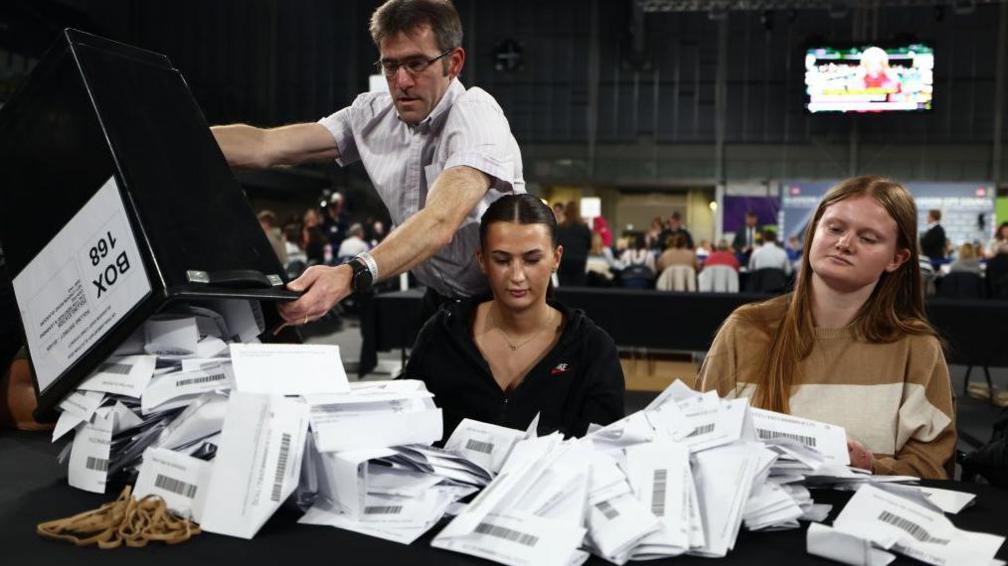
- Published
If the next Holyrood election was tomorrow, it would be widely expected that the SNP would win a fifth term in office.
By "win" I mean finishing as the largest party and seeking to govern as a minority administration.
That's the position the first minister John Swinney is in now, drawing support from rival parties on an issue-by-issue basis to get things done.
This is the sort of outcome that the recent trend in opinion polls, external points towards.
Labour tends to be in second place, with Reform UK third ahead of the Conservatives, Greens and Liberal Democrats.
Of course the election is not tomorrow, it is in exactly six months time on Thursday 7 May 2026.
Is that enough time for things to change?
Yes, and all parties will be working flat out between now and then to maximise their vote and their influence in the next parliamentary term.
Who are the front runners?
There have been times when Swinney has suggested the contest is between the SNP under his leadership and the politics of Reform UK led by Nigel Farage.
Some have argued that this approach has elevated Reform UK's position in the national debate.
If so, the SNP knows that will probably cost them fewer votes than it will the established pro-UK parties.
Farage will probably remain a bogeyman in the SNP's campaign to help their efforts to corral the anti-Reform UK vote.
But Swinney framed the political choice differently in a social media post this week.
In a video message to rural voters, he argued that "at the next election in Scotland, you'll either get an SNP government or a Labour government".
That is the contest Labour wants to have and the contest it believes voters will become increasingly focussed on as polling day draws nearer.
Their strategists think they can take advantage of an apparent decline in trust in the Scottish government and weaknesses in the SNP's record.
Not only does that mean Labour highlighting long waits on NHS treatment and the shortage of housing but also, according to one party source, demonstrating a "relentless desire to fix problems" like these.
Labour and approval ratings
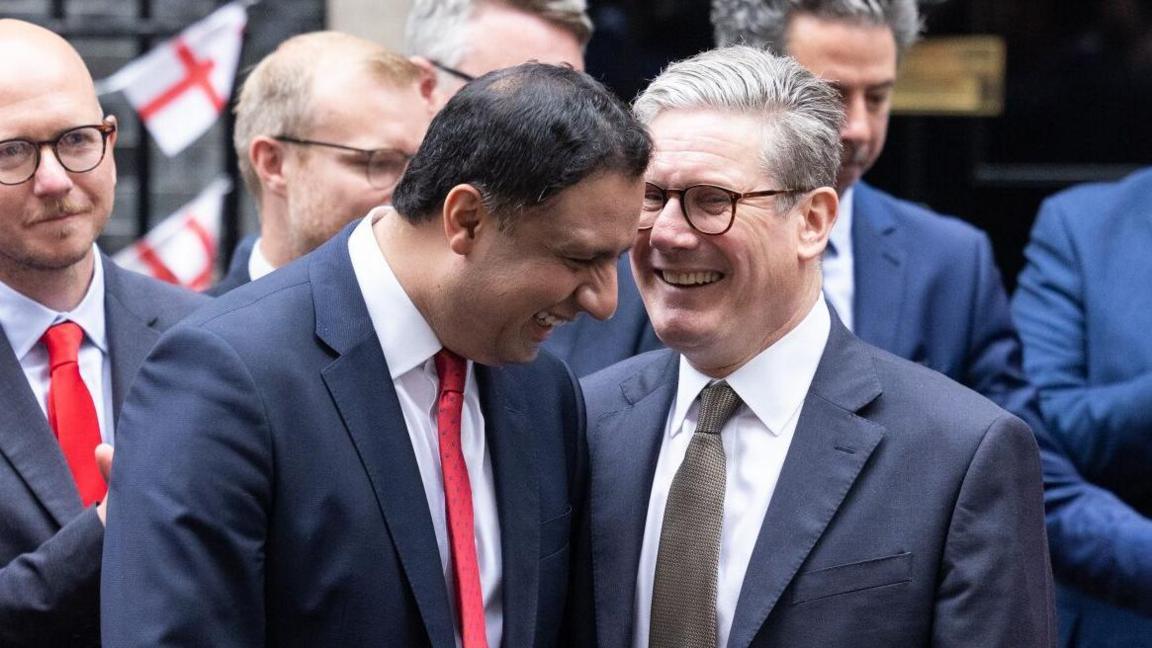
Scottish Labour leader Anas Sarwar with Keir Starmer outside Downing Street
Key policy differences should start to become clearer after Labour's policy conference (towards the end of November) provides a framework for their manifesto.
Already, party insiders point to their commitment to fundamentally renegotiate the GPs contract as an example of their willingness to act boldly.
The Labour strategy to offer "a new direction" is not without its problems.
Firstly, the party successfully traded on "change" at last year's UK general election but mishaps and mishandling in government seem to have quickly led to public disappointment.
The prime minister Sir Keir Starmer's personal approval ratings, external are desperately low and appear to be dragging Scottish Labour down.
In Edinburgh, party sources acknowledge the huge public anger directed at Starmer.
They also seem to think that voters will distinguish between the prime minister and their candidate for first minster - Anas Sarwar.
It's not clear what effort they might make to help ensure voters draw that distinction or how much they will leave it to their own wishful thinking.
You can be sure the SNP and others will be determined to link Sarwar to any unpopular decisions for which the UK government is responsible.
Talking of which, the UK budget this month could be a defining moment, with the Chancellor Rachel Reeves refusing to rule out tax rises and other potentially unpalatable choices.
The budget always results in some kind of spat between the Scottish government and the Treasury but Scottish Labour hope that will be "neutral" in its overall impact on their campaign.
Reform's remarkable position
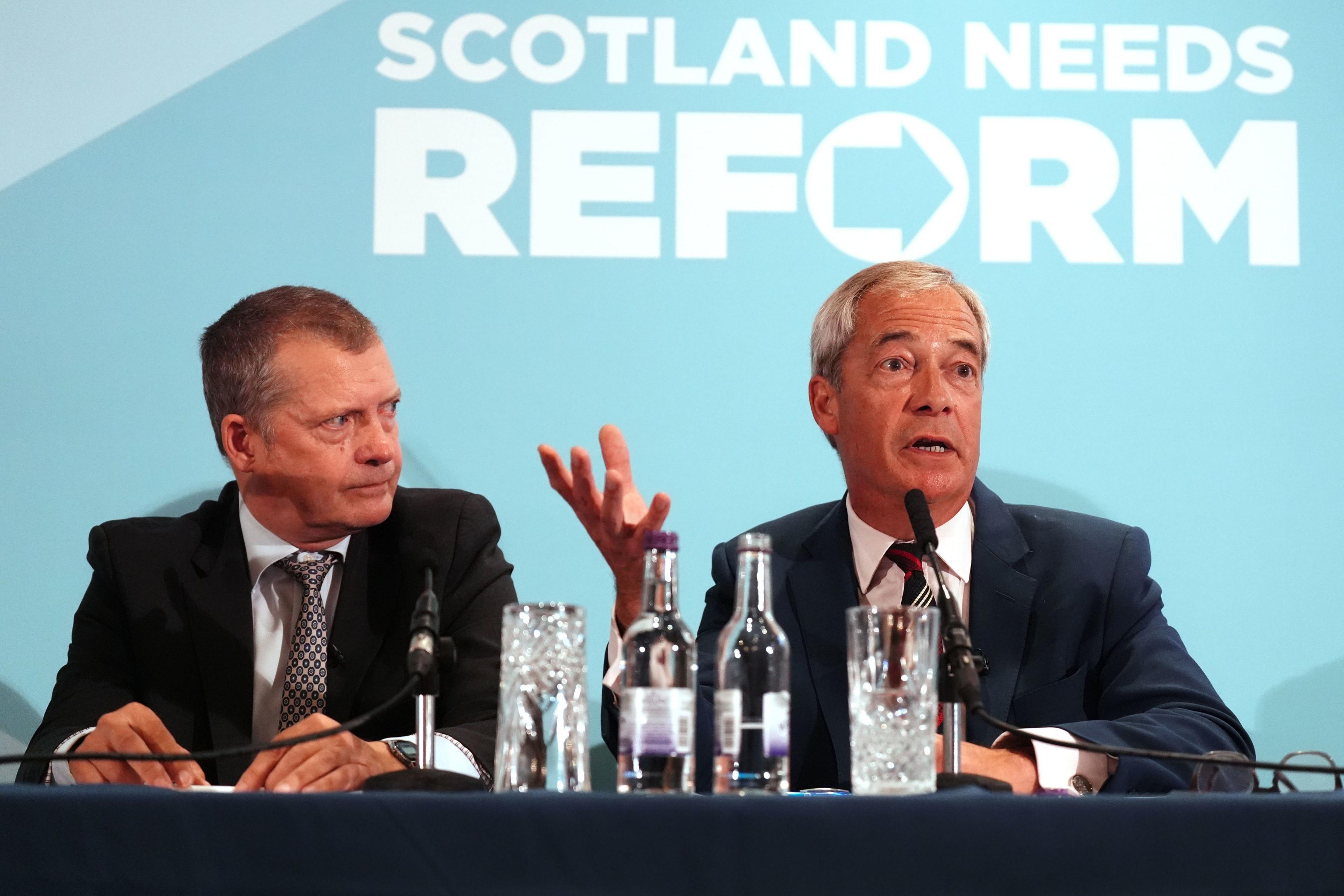
MSP Graham Simpson (left) defected from the Tories to Reform earlier this year
Scottish Labour seems much more focused on the SNP than it is on Reform UK, despite the latter being Sir Keir Starmer's principle target in his conference address.
Reform UK occupies a remarkable position in Scottish politics. It appears to be emerging as a major force without having any track record in opposition never mind government.
That appears to be its secret. It is untried and untested and therefore does not have a record to defend.
Instead, by simply not being the SNP, Labour or the Conservatives and promising to shake things up, it seems to be attracting support from those who are fed up with politics as usual.
The party leader Nigel Farage is known for taking a hard line on immigration and asylum. He has questioned carbon reduction targets and called for the acceleration of North Sea oil and gas exploitation.
These are policy areas under Westminster control. The party has yet to develop a Holyrood policy platform.
The former Conservative MSP Graham Simpson who defected to Reform UK has been put in charge of this process.
Alongside him, the party has nineteen councillors, mostly ex-Tories. Councillor Thomas Kerr from Glasgow chairs the party's Holyrood election campaign committee.
Does Reform pose an existential threat to the Scottish Conservatives?
- Published28 August
Huge tax cuts not currently realistic, Farage says
- Published3 November
Kerr is often trusted to speak for Reform UK without making blunders but he is not the Scottish party leader. There isn't one.
Farage has indicated that he will appoint a Scottish figurehead before the Holyrood election but as one party insider puts it: "Nigel is the leader. He is such a big personality, there's no point in trying to draw attention away from him".
Reform UK has said that it will field candidates in all Holyrood constituencies.
That will maximise its profile although it is the regional list ballot where it is most likely to pick up seats.
It is clearly still in the market for political talent as it is inviting candidate applications on its website for a non-refundable fee of £50.
That reflects the limited extent of the party's organisation on the ground. It does have regional branches but there is not yet one for each constituency.
Tory seats now 'hyper-competitive'
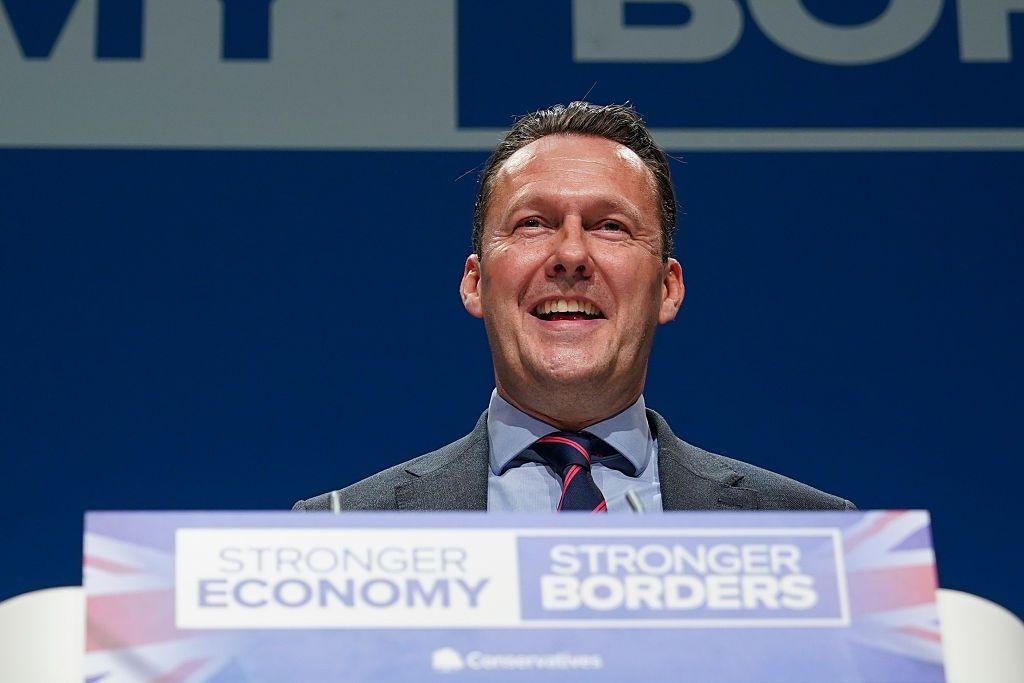
Russell Findlay has promised to cut what he describes as wasteful public spending
The party that is most obviously being squeezed by Reform UK is the Scottish Conservative and Unionist party, led by Russell Findlay.
They finished behind their right-wing rivals in the Hamilton, Larkhall and Stonehouse by-election, a displacement reflected in a run of national opinion polls.
Remember, the Scottish Tories start the Holyrood contest as the second largest party in parliament with 31 MSPs elected last time.
That is a strength in numbers they recognise is unsustainable because most of their seats come from the regional lists which they consider have now become "hyper-competitive".
That said, the Tories think they can still do well in constituencies in the north east and south of Scotland where they are seen to be head-to-head with the SNP and its revived plans for independence.
SNP hurting Scotland with 'wacky and woke' policies, says Findlay
- Published5 October
Badenoch calls for end to oil and gas windfall tax
- Published13 June
They will argue that Reform UK is a one-man band that risks depressing the vote for established pro-UK parties and helping the SNP in the process.
More generally, the Conservative pitch will be as a business-friendly party that wants to cut regulation, taxation and what they see as wasteful public spending.
Greens to push devolution

Ross Greer and Gillian Mackay plan to push devolution to its fullest extent
The Greens under the new co-leadership of Ross Greer and Gillian Mackay see potential for growth in this election.
They want to acknowledge public anger with politics and channel it not against migrants but against the super-rich.
They are developing plans to close tax loopholes and raise new revenues from land, property and private jets.
It may be that some of their proposals are beyond Holyrood's powers but part of their strategy is to push devolution to its full extent and to use these limitations to argue for independence.
The Greens will also trade on free bus travel for young people and other policies they were able to bring in as part of the Scottish government before their power-sharing deal with the SNP collapsed.
Scottish Greens promise free bus travel for all
- Published18 October
Greer and Mackay elected as Scottish Greens co-leaders
- Published29 August
They intend to occupy the political space to the left of both Labour and the SNP.
Unlike Labour and the Conservatives, the Greens do not have a UK leadership to potentially encumber them.
They also happen to see the high-profile leader of the Green Party of England and Wales, Zac Polanski, as both an ally and an asset.
Lib Dems 'increasingly ambitious'

Alex Cole-Hamilton and the Lib Dems welcomed former Tory Jamie Greene into the party in spring
The Scottish Liberal Democrats believe they are better placed than most to "capture the mantle of change" at the forthcoming vote.
That's because they have not been in power at either Holyrood or Westminster for more than a decade.
They think the public has become tired and frustrated having given almost every other political brand a go.
Cole-Hamilton urges disillusioned Tories to join Lib Dems
- Published21 September
Former Tory MSP Jamie Greene defects to Lib Dems
- Published4 April
The party, led by Alex Cole-Hamilton, is expected to produce a very short manifesto tightly focussed on practical steps that could be taken in key areas like health, education and the cost of living.
One party source said they are becoming "increasingly ambitious" - with 10 target constituencies including the four they are defending and several in the Highlands that elected SNP members last time.
The Lib Dems suspect the SNP's poll lead might prove illusory when the public becomes more focussed on the election in the New Year.
SNP to play on experience and governance
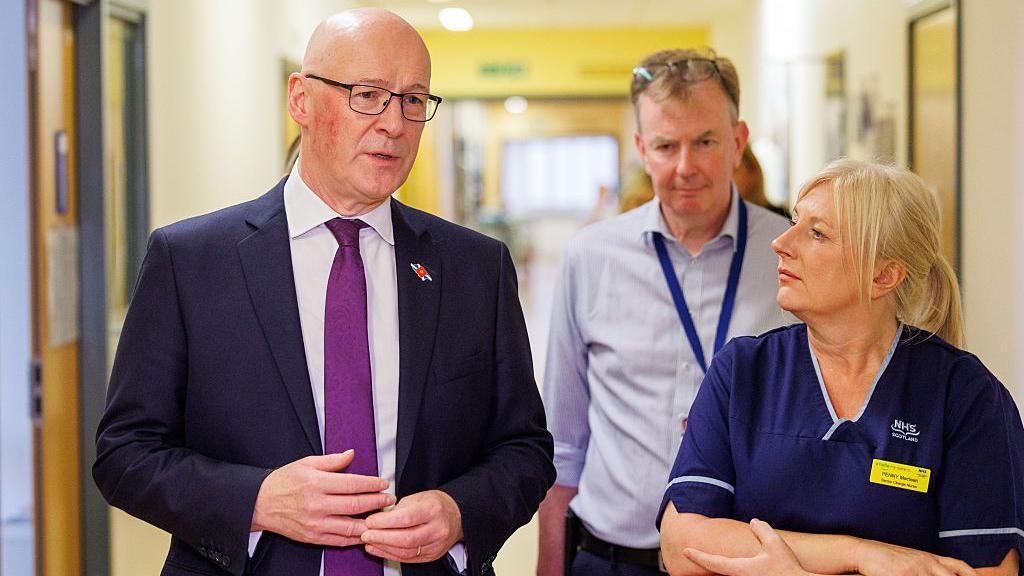
John Swinney visited the Queen Elizabeth University Hospital this week as he announced funding for the NHS
Having held power for more than 18 years, the SNP has demonstrated that it is highly skilled at winning elections.
The party believes it can do so again in 2026 with John Swinney in charge, despite losing heavily to Labour in the UK general election last year.
Why? Because Labour appears to have quickly fallen from public favour during its first year in office.
They will argue that Starmer has not delivered the change he promised and by extension, question why Scottish Labour should be trusted to realise a similar promise.
They can seek to make a virtue of Swinney's vast experience in government as a cabinet minister under both Alex Salmond and Nicola Sturgeon.
They may choose to portray him as a tried and tested figure, a stabilising force at a time of great uncertainty at home and abroad.
That potential strength could also be a weakness because there are few big decisions over the last two decades at Holyrood with which he cannot be associated.
SNP will create network of walk-in GP services, says Swinney
- Published13 October
Chris Mason: SNP are the latest proof that things change quickly in politics
- Published13 October
The SNP's opponents will try to pin any failures or underperformance in devolved public services on him be that overcrowded prisons, overstretched maternity services or much delayed road or ferry building projects.
Swinney can hardly shirk responsibility. Instead, expect him to highlight his efforts as first minister to focus the Scottish government on delivering improvements, especially in the NHS.
He sought to develop this narrative on a hospital visit this week when he highlighted reductions in some waiting times and expressed optimism that the NHS had "turned a corner".
Other examples of delivery by the May election might include scrapping peak rail fares, lifting the two child benefit cap and opening Scotland's first walk-in GP service.
He believes demonstrating the differences his leadership is making is the best way to rebuild trust with voters who have turned away from the SNP in recent years.
After a period of relative quiet on independence, Swinney has revived the debate on that issue and not just because it remains his ultimate political goal.
The SNP needs to promote independence to some extent to motivate and unite their political base and to try to win back some of their lapsed voters who believe in a cause that is more popular than their party.
There is a careful balance for the SNP to strike here between delivery in the present and their vision of an independent future.
That's because the more emphasis the party places on constitutional change, the more it risks undermining their leader's promise of relentless focus on the public's immediate priorities.
With six months to go, the SNP starts this period of the election campaign in front but sustaining that lead during a period of intense scrutiny is easier said than done.